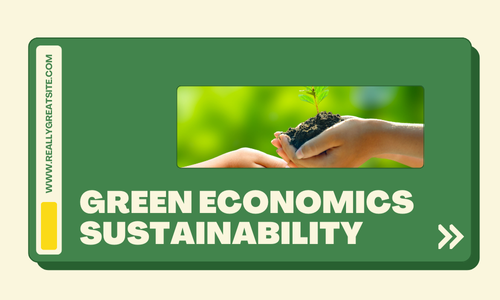This site may contain links to affiliate websites, and I may earn a commission for any purchases made through those links at no additional cost to you.

Green Economies and Sustainability: How Global Markets Are Evolving Toward Eco-Friendly Business Models
Green Economies and Sustainability: How Global Markets Are Evolving Toward Eco-Friendly Business Models
In the past few decades, the global economic landscape has undergone significant transformations, with the rise of digital technologies, globalization, and a more interconnected world economy. However, one of the most important shifts we are witnessing today, and which will continue to define the future of global markets, is the transition toward green economies and sustainable business models. As climate change accelerates, environmental degradation increases, and public awareness rises, governments, businesses, and individuals are turning their attention toward eco-friendly solutions.
The year 2025 represents a critical juncture in the pursuit of sustainable economic practices. Governments and industries around the world are increasingly realizing that the traditional growth model — one based on resource extraction, waste, and environmental harm — is no longer sustainable. Instead, the world is moving toward green economies, where economic activities and growth are aligned with environmental stewardship, social responsibility, and long-term ecological health.
In this blog post, we will explore the evolution of green economies, how sustainability is influencing global markets, and how businesses are adopting eco-friendly practices to thrive in a rapidly changing economic environment.
The Rise of Green Economies: A Global Imperative
The concept of a green economy is grounded in the idea that economic growth and environmental sustainability are not mutually exclusive. A green economy seeks to decouple economic development from environmental degradation by promoting resource efficiency, renewable energy, sustainable agriculture, and low-carbon technologies. At the heart of the green economy movement is the recognition that the planet’s resources are finite, and continuing to exploit them without regard for their long-term impact is a risky and unsustainable path.
In 2025, the shift toward green economies is being driven by several critical factors:
- Climate Change and Environmental Crisis
The overwhelming evidence of climate change and its disastrous consequences has made it clear that we cannot continue with business as usual. Extreme weather events, rising sea levels, and biodiversity loss are no longer distant threats — they are immediate challenges that demand action. Governments, businesses, and consumers are all facing the pressing need to transition to more sustainable practices to mitigate the impact of climate change. - Sustainability as a Competitive Advantage
As the demand for sustainable products and services grows, businesses that fail to adopt eco-friendly practices risk losing customers, facing higher costs, or being outpaced by more agile competitors. In contrast, companies that embrace sustainability are often rewarded with increased brand loyalty, cost savings, and access to new markets. Today’s consumers are more eco-conscious than ever before and are increasingly making purchasing decisions based on a company’s environmental performance. - Government Regulations and International Agreements
Governments around the world are responding to the environmental crisis by implementing stricter regulations, carbon pricing mechanisms, and sustainability goals. The Paris Agreement, which aims to limit global temperature rise to well below 2°C, has set the stage for countries to adopt policies that align with carbon reduction targets. In 2025, many countries are intensifying efforts to reach these targets, creating a favorable environment for green business models. - Technological Innovation and Green Investments
Technological advancements in renewable energy, energy efficiency, waste management, and carbon capture are revolutionizing the way industries operate. Innovations in solar and wind energy, electric vehicles, battery storage, and sustainable manufacturing processes are opening up new opportunities for businesses to reduce their environmental footprint while driving economic growth. Additionally, the green finance sector, including sustainable investments and green bonds, is growing rapidly, providing businesses with access to capital to fund their environmental initiatives.
Key Sectors Shaping the Green Economy
Several sectors are at the forefront of the green economy movement, each contributing to the transition toward more sustainable business models. These industries are embracing innovation, efficiency, and sustainability to reduce their environmental impact and drive economic growth.
- Renewable Energy and Clean Technologies
The renewable energy sector is perhaps the most visible example of the green economy in action. Solar, wind, hydroelectric, and geothermal energy are rapidly replacing fossil fuels as the primary sources of energy. In 2025, the cost of renewable energy has fallen significantly, making it competitive with traditional energy sources, and many countries are on track to meet their clean energy goals.
The growth of electric vehicles (EVs) is also a major contributor to the green economy. As battery technology improves and charging infrastructure expands, EVs are becoming more affordable and accessible to consumers. Major automakers are investing heavily in electric mobility, and governments are implementing policies to encourage the transition to cleaner transportation options.
- Sustainable Agriculture and Food Systems
Agriculture is one of the largest contributors to greenhouse gas emissions, deforestation, and biodiversity loss. However, the sector is undergoing a transformation as farmers, food companies, and consumers embrace more sustainable practices. Regenerative agriculture, which focuses on soil health, biodiversity, and carbon sequestration, is gaining traction. Vertical farming, precision agriculture, and plant-based diets are also contributing to more sustainable food systems.
In 2025, consumers are increasingly demanding plant-based and sustainably sourced products, pushing food companies to adopt more eco-friendly practices. The rise of lab-grown meat and alternative proteins is also transforming the food industry, offering more sustainable options for the global population.
- Circular Economy and Waste Reduction
The concept of a circular economy, which aims to minimize waste and make the most of resources, is gaining momentum. Unlike the traditional linear economy, which operates on a “take, make, dispose” model, the circular economy aims to prolong product lifecycles, minimize waste, and encourage material recycling and reuse.
Companies are now designing products with longer lifespans, greater durability, and recyclability in mind. The rise of product-as-a-service business models, where consumers lease products instead of purchasing them outright, is helping to reduce resource consumption. In 2025, businesses that embrace circularity are benefitting from reduced operational costs, increased efficiency, and new revenue streams.
- Green Building and Sustainable Real Estate
The construction and real estate sectors are also undergoing a green transformation. Green building practices, such as using energy-efficient materials, reducing waste, and integrating renewable energy sources, are becoming the norm in new developments. The growth of smart cities, which use data and technology to optimize energy consumption and reduce emissions, is helping to create more sustainable urban environments.
In 2025, eco-friendly building certifications such as LEED (Leadership in Energy and Environmental Design) are influencing property development, and investors are increasingly prioritizing green real estate projects due to their long-term value and lower operating costs.
- Finance and Green Investment
The finance sector plays a crucial role in the development of green economies. Green finance refers to investments made in projects, companies, and technologies that promote environmental sustainability. This includes green bonds, sustainable investing, and environmental, social, and governance (ESG) criteria that guide investment decisions.
In 2025, green finance is a rapidly growing sector, with trillions of dollars flowing into sustainable investments. Investors are increasingly aware of the risks posed by climate change and are seeking opportunities to invest in companies and projects that are aligned with environmental and social goals. As sustainability becomes a key driver of financial performance, businesses that embrace ESG principles are attracting more capital and gaining a competitive edge.
Challenges and Opportunities for Businesses
While the shift toward green economies presents enormous opportunities, it also comes with challenges. The transition to sustainable business models requires significant investment in new technologies, processes, and infrastructure. Companies must also navigate complex regulatory environments and address stakeholder concerns around environmental and social impacts.
However, those that successfully adapt to the green economy are likely to see numerous benefits, including:
Cost Savings: Companies that reduce energy consumption, minimize waste, and optimize resource use can lower operational costs and improve their bottom line.
Innovation and Competitive Advantage: Embracing sustainability can drive innovation, helping businesses create new products and services that meet growing consumer demand for eco-friendly options.
Brand Loyalty and Market Share: Consumers increasingly prefer to buy from companies that demonstrate a commitment to sustainability, leading to stronger brand loyalty and increased market share.
Risk Mitigation: By adopting sustainable practices, companies can better manage the risks associated with climate change, resource scarcity, and regulatory changes.
Conclusion: The Future of Green Economies
As we move into 2025 and beyond, the global economy is increasingly driven by the need for sustainability and environmental responsibility. Green economies are not just a trend — they are the future of global markets. Businesses that embrace sustainability and adopt eco-friendly business models are better positioned to thrive in a rapidly changing world.
The transition to green economies is not without its challenges, but the opportunities are immense. From renewable energy to circular economies, sustainable agriculture to green finance, the shift toward a more sustainable world is creating new avenues for growth and innovation. In the years to come, we can expect to see more companies adopting green practices, governments implementing ambitious environmental policies, and consumers making eco-conscious choices that will drive the global economy toward a more sustainable future.
As we continue this journey toward sustainability, the key will be collaboration — between governments, businesses, and individuals. Only through collective action can we build a truly green economy that benefits both people and the planet.




